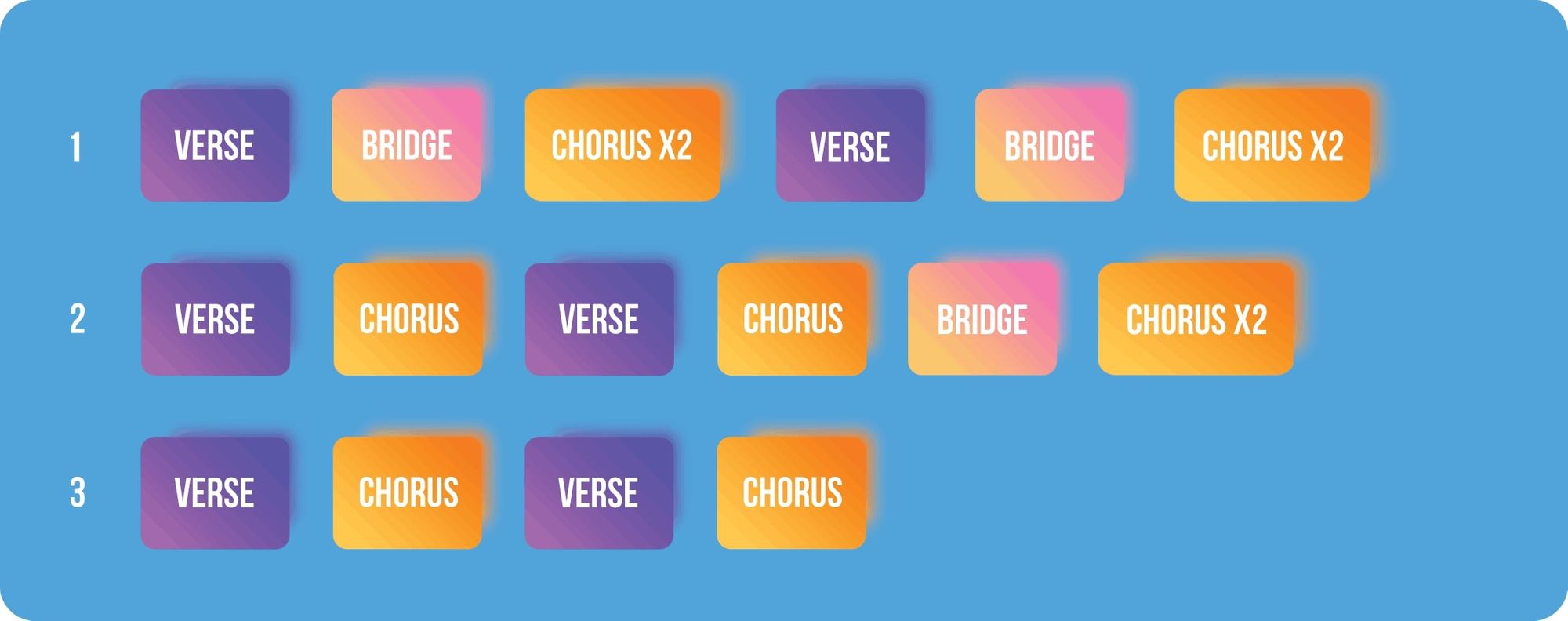Parts of a Song - Explained: All you need to know about Song Structure for Songwriting

If you aspire to songwriting, you will be happy to know that the structure and individual components of a song can actually be quite easy to learn and practice with. Song structures actually only have 7 main parts to get accustomed to. If that isn’t encouraging enough, you will quickly find that each of these main parts are quite flexible. This underpins the fact that once you know the basic fundamentals of this structure, your song writing possibilities are limitless!

The Various Components of a Song
Intro
This is the moment of truth for any song. Right out of the gate, the intro helps to establish the timbre, mood, and tone of the song and what the viewer may assume the whole track may sound like. While it is the job of the rest of the parts of the song to either meet or defy your audience’s expectations, the intro is critical to delivering the best possible first impression.
Verse
While the chorus is the central focus of a basic song structure, the verse acts as part of the initial first impression introduced in, well, the intro! It advances the chord progressions of the song towards the Lift.
Pre-chorus (Lift)
Building upon the verse as the verse builds upon the intro, the pre-chorus or lift in song structure is what builds anticipation. This can be done through a variety of different methods, which we will briefly touch upon further down!
Chorus
The chorus is, quite simply, the main critical idea of your song, where most of its essence can poetically as well as practically dwell. Commonly, the chorus repeats this idea in melodic fashion, and the chorus overall serves as the main body of the song.
Bridge
Bridges are critical elements in song structures. These handy fellows help keep your song from being monotonous. They bring dynamics and in the right place can shakeup your song for the better.
Break
Most often in the form of an instrumental break, breaks are also a type of transition point in any song structure. They can be both transition points to other parts in your song, or can even be used as transition points across an album of songs, as one song blends to another.
Outro
These can take a few different forms, but irregardless, the outro is as you can assume is the opposite of the intro. Outros neatly bring songs to a close.
Common Approaches to Song Structure
As you study different song structures once you have gained a solid grasp of the structure of a song, you will notice similarities as well as differences. We shall cover some of these differences and their differences in the next session. For now, let’s take a look at how parts of a song are arranged in some common song structures.
Here are some examples of very popular common song structures:

There are also several types of structures that exist by name you can search up and experiment with in your songwriting! Some of these include the Verse-Refrain, Verse-Chorus, and Verse-Prechorus-Chorus to name a few.
How Structure Approaches Differ and How They Can Be Used
Different song structures can achieve many different things, beyond just their obvious structural differences when illustrated on a chart. For some examples, free form is great for songs that you intend to have little to no repetition, making it a difficult or unlikely choice if you wish to utilise repetition heavily.
Another example can be found in Verse-Refrain, where it is quite simple and easy to work with, with few drawbacks as it has proven quite versatile. It has the tradeoff of having been not as popular later on, so you will have to look back to the 20th century for more frequent examples of songs using this structure.
Meanwhile, the prechorus is a highly common one seen in modern music, giving it plenty of contemporary examples of its structural usage. Verse-Prechorus-chorus works best when the song it is incorporated in is built around it, rather than the former being something retroactively added to an existing song structure you have written rough-draft.
General Tips to Conclude With
We hope that this general breakdown is a helpful resource for understanding the basics of song structure and songwriting! Before we close, let’s explore some tips for the future when going to write your own songs
- The first pointer is about the time just before you go to write: brainstorming. Try to develop a good idea of what you want to put into your song, and what you want it to put out to the audience.
- Also think about what goes into the structure of a song in general, and how it can make each song special. This includes everything from timbre, mood, and tone all the way to what instruments it might be good with, or accompanying lyrics. Each of these are important components of the soul of the song itself and how it demonstrates your creativity.
- Experiment, experiment! Indeed, never feel the need to pigeonhole yourself to any single type of song structure. Always feel free to mix and match to see what new structures you can create when writing music. Beyond the 7 parts that go into a song, no matter how you arrange them in a structure, the possibilities are indeed infinite.
- Lastly, remember that there are no mistakes, just happy accidents as Bob Ross would put it. That painting adage still very much holds true in the music world; if a song structure sounds displeasing to you, it is always a learning experience. You could perhaps think of it as an example of a structure that may need to be tweaked, or perhaps it just needs a little bit of spice even.
With all of these in mind, your budding grasp of the basic parts of a song and your inspirations will surely have you writing music in no time.
Good luck and happy writing!
